Beside Mele Cast S1 Wi-Fi display dongle, Mele also sent me their X1000 Blu-ray Navigation Android Box. This device is interesting as it features a new SoC, namely Telechips TCC8935 dual core Cortex A9, supports Blu-ray navigation, SATA drives, and comes pre-loaded with XBMC. You can read my Mele X1000 post to get the full hardware specifications. Today, I’ll show unboxing pictures and video, as well as photos of the PCB. In a few days, I’ll follow up with a complete detailed review.
Mele X1000 Unboxing Pics and Video
I’ve received the device in a carton box, with a sticker showing the specs, and providing a link to meleshop.com. The product is listed in this site but they don’t actually sell it there. and instead Mele X1000 can be purchased in Aliexpress for $179, including shipping via Singapore Post.
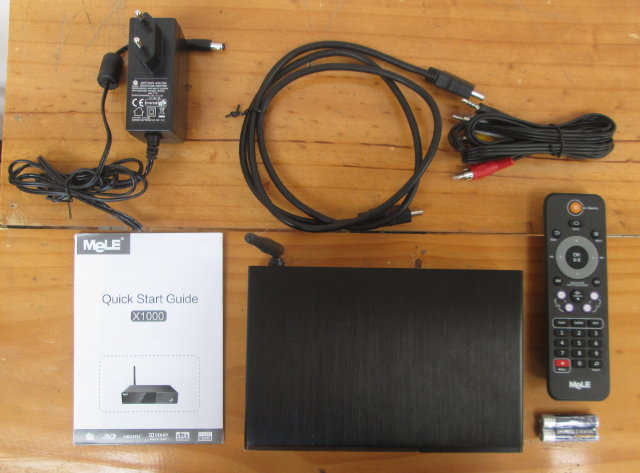
In the package, you’ll find the media player, an IR remote control with two AAA batteries, HDMI and AV cables, a rather large 12V/2A power supply, and a Quick Start Guide describing the ports, and mostly showing how to configure and use the device user’s interface and XBMC, after installing it.
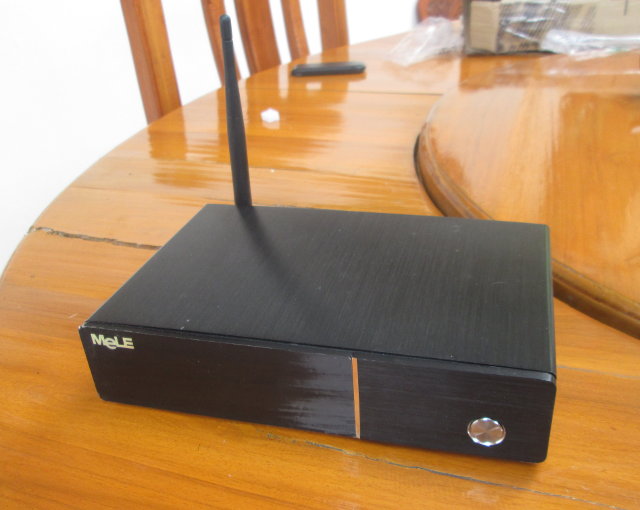
The enclosure is pretty large (19x12x4 cm) compared to recent Android TV boxes, but it’s made of aluminum, and not cheap plastic like most devices on the market. There’s a small LCD display on the left of the panel, as well as the power button.
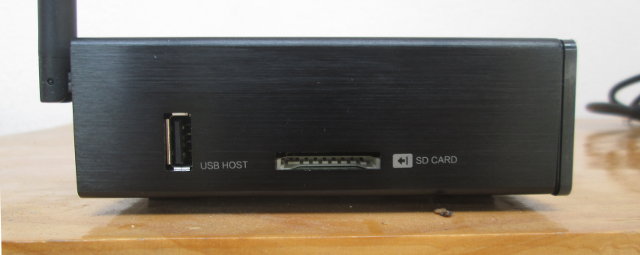
On the side, we’ve got one USB host port, and an SD card slot.

But most of the ports can be found on the rear panel: a micro USB port, AV out, DC-in, HDMI, optical S/PDIF, Ethernet and another USB port. On the top left, you’ll also find a the Wi-Fi antenna and a SATA connector. Unless there are some SATA enclosures on the market (not USB to SATA), your hard drive or SSD would just be places on the furniture, and on the top of the box with some isolation. On the bottom of the enclosure, there are some logos with CCC and CE certifications, XBMC, HDMI, Android, 3D, DTS Dolby, and Dolby Digital Plus. I’m confident these last two audio codecs will be supported by the player, as Telechips actually paid for the licenses…
You may watch the unboxing video below.
Mele X1000 Board
As usual I’ve opened the box. With metallic casing, it’s usually pretty simple, as you don’t have those pesky plastic clips. I just had to remove 4 screws on the bottom, and slide the case to access the board.
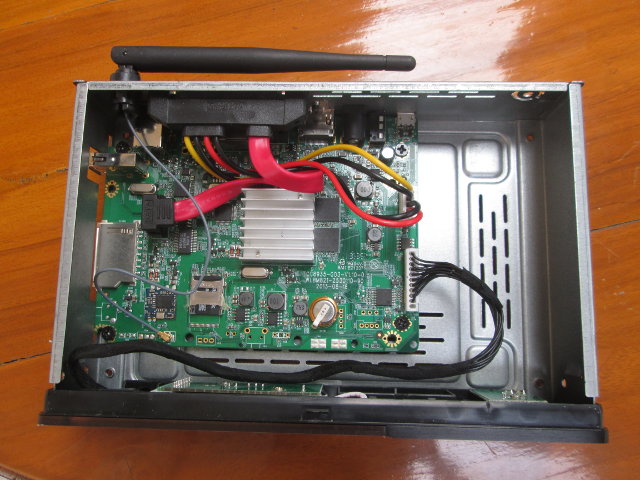
We can already see some interesting features on the board. There’s no 4GB NAND flash, but instead the company used a 4GB SD card. I only see this one with HiaPad Hi802 (GK802) mini PC. They are also using a battery, most probably for the RTC. Again, it’s something I’ve never seen on the other Android media players I’ve tested.
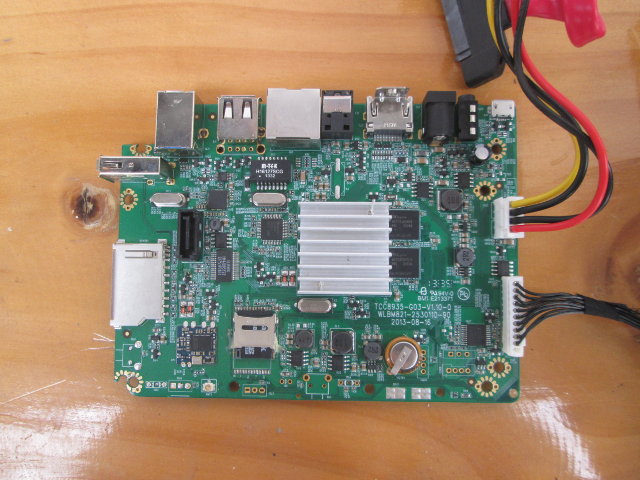
Then I remove 4 or 5 other screws, disconnected the Wi-Fi antenna, and the SATA cables to completely remove the board from the enclosure. You’ll notice a connector at the top left of the board, that’s actually hidden when the board is fitted into the enclosure. It’s a Standard-B USB 3.0 connector. Telechips supports USB 3.0, so I suppose in theory it would have been possible to use Mele X1000 as an external USB hard drive, but the company told me they won’t solder the connector for mass production. The serial console pins appear to be available at the bottom right corner on the picture. The silkscreen reads “TCC8935-g03-v1.10-0” and “WLBM821-2530110-90”. I’m not sure what the second stands for, but the first could be useful once sources are leaked or released.
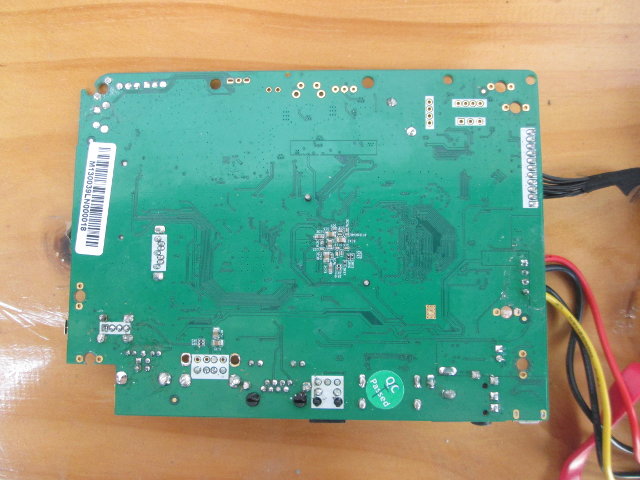
There’s not much to see on the back of the board.
That’s all for today, I’ve got some testing to do…

Jean-Luc started CNX Software in 2010 as a part-time endeavor, before quitting his job as a software engineering manager, and starting to write daily news, and reviews full time later in 2011.
Support CNX Software! Donate via cryptocurrencies, become a Patron on Patreon, or purchase goods on Amazon or Aliexpress





yeah cool.
Since I understand that Mele does not do any software development themselves can we assume they just took the Android APK binary builds that VidOn.Me have for their A200 (AllWinner A31) box and released that without changes as both uses Android standard OpenMAX based API for video acceleration or?
If so then Mele too is violating the GPL license if they don’t resource the source code for the version of XBMC that they use, which is something that VidOn.Me have not yet done either.
How do we know this is not using libstagefright? Or even externalplayer?
Yeah this is a strange one indeed, BD menu support is a complicated topic.
Officialy XBMC supports libbluray the open source BD playback system, but this system can barely display the menus on only a handful of movies.
Any fully working BD menu system must be coming from another source, I’ve not seen the Videonme in action or it’s claimed BD menu system actually work so I’m very curious about the whole thing and this unit too.
Also be aware that an officially licensed BD menu system these days requires Cinavia DRM so whatever BD menu system is in action must be a reverse engineering effort.
Anyway very interested to what happens when you feed it a Blu-ray ISO image.
@Hedda
@Someone from the other side
@Dan
I have started to test it a little. XBMC is not installed, they ask you to find it online an install on it on the device in the Quick Start Guide. Since there are several versions of XBMC, I don’t know which one I should install, so I’ve asked them. There’s just an XBMC Plugin app.
I’ve download sintel blu-ray ISO .. Testing soon. Review will be published on Thursday I think.
What we do know is that a VidOn.Me developer have posted on the XBMC forums that for their A200 (AllWinner A31) hardware they have with the help of Fengtao Software (of DVDFab fame) developed their own in-house internal video player for XBMC that supports Blu-ray menus.
This developer from VidOn.Me claimed that what they developed is a new internal player for XBMC, and not an external player. Because of that being an internal player for XBMC and not an external player, VidOn.Me’s new in-house developed internal player for XBMC is bound by XBMC’s GPL license.
I think that we can assume that what Fengtao Software (of DVDFab DVD-Video and Blu-ray ripping software fame) contributed to the code must at least be the Blu-ray Disc decryption part, however since Fengtao Software also have their own DVDFab Media Player video player which supports Blu-ray menus too then I guess that Fengtao Software developers might actually be more deeper involved than just only the Blu-ray Disc decryption part.
Allwinner A31 SoC VPU uses an OpenMAX based API for hardware video acceleration that support Android’s own libstagefright and mediacodec APIs, and since that is the case I suspect that VidOn.Me’s new in-house developed internal player for XBMC does indeed Android’s own libstagefright and mediacodec APIs for video acceleration.
As both the Telechips TCC8935 SoC VPU and the Allwinner A31 SoC VPU does use the OpenMAX based API which in turn is exposed on Android via libstagefright and mediacodec APIs, it should be possible to use any version of XBMC that supports libstagefright or mediacodec on any Android media player hardware that uses those SoCs.
Again neither VidOn.Me developer nor Fengtao Software have yet released any source code for their video players, though they both claim their software is based on XBMC thus making them violate the GPL license since they still have not released they code as open source which they are required to do if asked.
References to fact-check VidOn.Me and Fengtao/DVDFab collaboration for Blu-ray capable media player software based on XBMC without fully releasing proper source code
http://www.businesswire.com/news/home/20131105005640/en/World%E2%80%99s-Complete-Blu-ray-Navigation-Box-Android-Coming#.UxHTj-69KSM
http://en.dvdfab.cn/media-player.htm
http://dvdfab.cn/opensource.htm
http://en.dvdfab.cn/faq/?type=media_player
http://blog.dvdfab.cn/blupath.html
http://blog.dvdfab.cn/cinavia-protection.html
http://forum.dvdfab.com/showthread.php?t=16722
http://forum.xbmc.org/showthread.php?tid=123801
http://forum.xbmc.org/showthread.php?tid=180251
http://forum.dvdfab.com/showthread.php?t=16722
For the impatient here’s a video I’ve shot with Mele X1000 user’s interface and setup menu. The good thing is that it’s highly customizable.

I’ve tried to install XBMC Frodo 12.3, but it plays video with software decoding (or it’s super slow hardware decode…), so there are unwatchable.
At this point of testing, Mele X1000 can’t be used as a networked media player (SAMBA does not work), can’t play Blu-ray ISO (sintel), and does not support XBMC. The whole thing is frustrating.
@cnxsoft
Sorry YouTube failed to process the video…. Here’s the link – https://www.youtube.com/watch?v=tE-mepzp9z0&feature=youtu.be
Does Samba really dont work? Cant believe..
I will get my device soon
@cnxsoft, you need to either install a XBMC 13 “Gotham” Beta or Nightly Builds
http://mirrors.xbmc.org/releases/android/arm/
http://wiki.xbmc.org/index.php?title=Development_builds
either that or get XBMC build from VidOn.Me from their A200 from their forums.
XBMC Frodo 12.x does not support hardware acceleration on Android at all.
FYI; XBMC Frodo 12.x is over a year have never supported VPU off-loading.
XBMC 12.x “Frodo” really just had initial experimental support for Android.
XBMC 13 “Gotham” will be the first version to properly support Android
Yeah, but is hardware decoding for telechips included on XBMC 13?
Yes because XBMC 13 now support both both Android’s libstagefright API and Android’s Media Codec API. So as long as the hardware manufacturer supports one of those standard APIs on Android then XBMC 13 will support it.
You see those two APIs acts as a man-in-the-middle between the XBMC and the VPU hardware, translating all calls between them. So XBMC does not specifically need to support Telechips proprietary VPU, as instead XBMC only need to support Android’s libstagefright API and Android’s Media Codec API, and as long as Telechips write driver for Android’s libstagefright API or Android’s MediaCodec API then they does not specially need to support XBMC.
XBMC (or any other media player software on Android) libstagefright API / MediaCodec API software driver for hardware VPU supporting libstagefright API or MediaCodec API hardware VPU
http://forum.xbmc.org/showthread.php?tid=168268
http://forum.xbmc.org/showthread.php?tid=175626
https://source.android.com/devices/media.html
http://developer.android.com/reference/android/media/MediaCodec.html
Android 4.0 and 4.1 uses libstagefright API while Android 4.2 and later uses then new MediaCodec API
The problem that XBMC have is that not all hardware manufacturers support Android libstagefright API or MediaCodec API, however Telechips does not their newest SoCs. Allwinner for example does not support those for their older A10 and A20 series SoCs, but they do support the MediaCodec API for their newer A30 and A80 series SoCs. Amlogic does not either support Android libstagefright API or MediaCodec API but they have instead at least opened source their API and libraries for hardware decoding so that XBMC could integrate support for that.
You can kind-of compare this translation API concept to how OpenGL API and DirectX API works for graphics.
Modern game engines and graphics doesn’t speak to the hardware directly, instead the games have a rendering engine that speaks to OpenGL API or DirectX API, and that in turn speaks to the hardware device drivers which is the actual thing that talks to the hardware. That way the game developers does not really need to care what kind of graphics hardware is underneath as the OpenGL API and DirectX API hide and translate it all for them, and all you sacrifice is a little flexibility and overhead in performance optimization.
Standardization like this might makes things less flexible but it also makes much more compatible and easier to support.
@Hedda
Thanks for the update. The version I installed (12.3) was released at the end of December 2013, so i thought it might.
So that means Gotham (13) supports all platform compliant with libstagefright API or MediaCodec API, and as per your comment I understand most ARM SoC will support them, except AMLogic, and the earlier Allwinner SoC (A1x, A20).
I also assume XBMC 13 will also make it to Google Play once it is officially released.
Recently acquired the male x 1000 … had installed the xbmc..to problem is that trying to add channels tells me could not play the media file please cheek IT what’s wrong;
My MeLe is using Kodi 14.2 and goes fine. I have not any problem with this equipment. In 1080p all goes charming. I deleted Frodo 12.3 to was installed from original and then I installed Kodi … No problem. The SD you can remove it and installed.
How can you upgrade the memory sd 4gb class 4 to a sd 16gb class 10 in this box?
@Noticiero
It should be possible, but I’m not sure how the firmware is installed. So you may end up with only 4GB actual usage after installing the firmware, and the last partition will need to be resized.
The firmware haves two files: .rom and .fai, but when you make the firmware using some software the melex1000 dont start.
Update works only on the original internal microsd but if you wish change it, melex1000 dont start, go black screen http://androidpc.es/blog/2014/04/03/mele-x1000-firmware-v4_00-20140305-19-y-manual-actualizacion-soc-telechip-tcc8935/
Sir,
Could you please share the firmware on Mele x1000 V1.0.2 for usb installation as my software crashed. thank you for your kind support